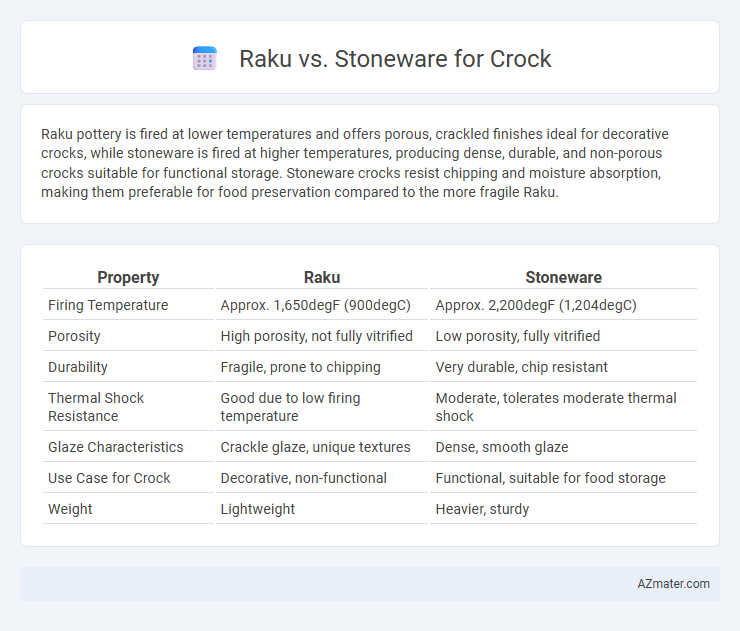Raku pottery is fired at lower temperatures and offers porous, crackled finishes ideal for decorative crocks, while stoneware is fired at higher temperatures, producing dense, durable, and non-porous crocks suitable for functional storage. Stoneware crocks resist chipping and moisture absorption, making them preferable for food preservation compared to the more fragile Raku.
Table of Comparison
| Property | Raku | Stoneware |
|---|---|---|
| Firing Temperature | Approx. 1,650degF (900degC) | Approx. 2,200degF (1,204degC) |
| Porosity | High porosity, not fully vitrified | Low porosity, fully vitrified |
| Durability | Fragile, prone to chipping | Very durable, chip resistant |
| Thermal Shock Resistance | Good due to low firing temperature | Moderate, tolerates moderate thermal shock |
| Glaze Characteristics | Crackle glaze, unique textures | Dense, smooth glaze |
| Use Case for Crock | Decorative, non-functional | Functional, suitable for food storage |
| Weight | Lightweight | Heavier, sturdy |
Introduction to Raku and Stoneware
Raku pottery is characterized by its unique firing process that involves rapid heating and cooling, producing distinctive crackled textures and vibrant glazes, making each piece highly individualistic. Stoneware, known for durability and versatility, is fired at higher temperatures between 1,100degC to 1,300degC, resulting in a dense, non-porous ceramic ideal for everyday crock use. Both materials offer distinct aesthetic and functional qualities, with Raku favored for artistic expression and Stoneware preferred for practical, long-lasting kitchenware.
Key Differences Between Raku and Stoneware
Raku pottery is characterized by its rapid firing process and unique surface textures, often resulting in crackled glazes and metallic finishes, while stoneware undergoes a slower, high-temperature firing that produces dense, durable, and non-porous ceramics ideal for functional use. Raku pieces are typically more fragile and decorative due to their porous nature, in contrast to stoneware's robust strength and resistance to chipping and thermal shock. The aesthetic variability in raku contrasts with the consistent, earthy tones of stoneware, making each suitable for different applications in crockery and art.
Origins and Historical Context
Raku pottery originated in 16th-century Japan, developed for tea ceremony bowls with a focus on spontaneity and unique glaze effects achieved through rapid cooling. Stoneware dates back to ancient China around 16th century BCE, known for its durable, dense, and vitrified clay ideal for everyday use and storage. Both Raku and stoneware reflect their cultural origins, with Raku emphasizing artistic expression and stoneware prioritizing practicality and longevity.
Materials and Clay Composition
Raku pottery is crafted from porous, low-fire clay that allows for rapid heating and cooling during the firing process, resulting in unique crackled surfaces and organic textures. Stoneware utilizes high-fire clay composed of dense, vitrified materials that provide durability, non-porosity, and resistance to chipping, ideal for functional crocks. The distinct mineral compositions in raku and stoneware clays directly influence their thermal properties and final appearance, making them suited for different aesthetic and practical applications.
Firing Techniques Compared
Raku firing involves rapid heating and cooling cycles, typically removed from the kiln while red-hot and cooled in open air or combustible materials, resulting in unique crackled surfaces and metallic finishes. Stoneware firing uses slow, high-temperature firing at around 1200degC to 1300degC, creating dense, non-porous, and durable ceramics with uniform glaze maturation. Raku offers unpredictable texture and visual effects ideal for artistic pieces, whereas stoneware emphasizes strength and functionality suited for everyday crock use.
Durability and Functionality
Stoneware crocks are highly durable, fired at high temperatures between 1,100degC and 1,300degC, resulting in a dense, non-porous surface that resists chipping and cracking during daily use. Raku crocks, fired at lower temperatures around 1,000degC and rapidly cooled, are more fragile and prone to thermal shock, making them less suitable for functional kitchenware. Stoneware excels in functionality with its heat retention and resistance to moisture, ideal for fermentation and long-term food storage, whereas raku is primarily decorative due to its delicate nature.
Artistic and Aesthetic Qualities
Raku pottery boasts a unique, unpredictable surface texture and vibrant crackled glaze achieved through rapid firing and cooling, enhancing its artistic appeal with each piece's distinct character. Stoneware crocks offer a more durable, earthy aesthetic with smooth, dense surfaces and subtle, natural glaze tones that emphasize functionality alongside rustic beauty. Both materials showcase artisanal craftsmanship, but Raku emphasizes bold visual drama while Stoneware highlights timeless, refined simplicity.
Common Uses in Crock Making
Raku pottery is primarily used for decorative crocks due to its unique, crackled glaze and unpredictable firing effects, making each piece visually distinctive and suitable for artistic displays. Stoneware crocks dominate functional applications thanks to their durability, non-porous surface, and resistance to thermal shock, ideal for food storage, fermentation, and everyday kitchen use. The high-fired nature of stoneware ensures long-lasting utility in crocks, while raku's low-fired, porous characteristics limit its practicality in moisture retention or food safety.
Pros and Cons of Raku vs Stoneware
Raku pottery offers a unique, artistic finish with its rapid cooling process that creates metallic and crackled effects, making each piece highly unique and visually striking. However, Raku is porous and fragile, requiring sealing and careful handling, which limits its practicality for everyday crock use. Stoneware, by contrast, provides durability, non-porosity, and resistance to chipping and thermal shock, ideal for functional, everyday crocks but lacks the distinctive aesthetic variations Raku produces.
Choosing the Best Option for Your Crock
Raku pottery features a unique firing process that creates crackled, unpredictable glazes, making it ideal for decorative crocks rather than practical use. Stoneware offers durability, non-porous surfaces, and heat resistance, making it the preferred choice for functional crocks used in food storage and fermentation. Choosing stoneware ensures longevity and safety in everyday crock applications.

Infographic: Raku vs Stoneware for Crock
 azmater.com
azmater.com